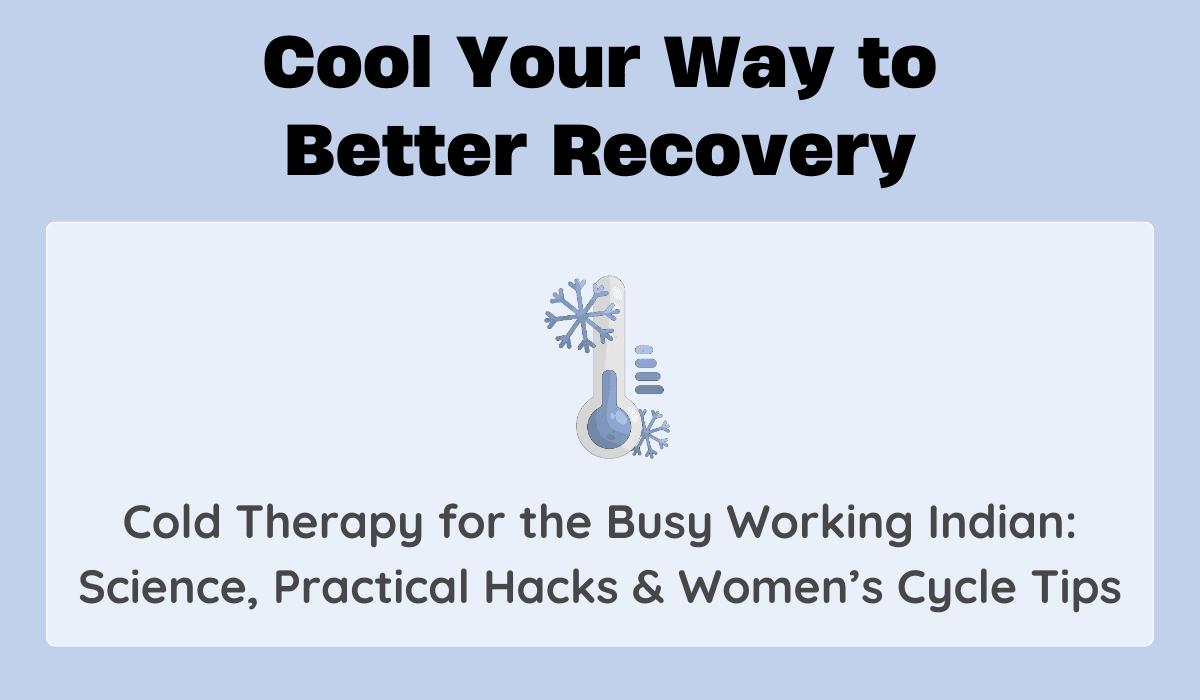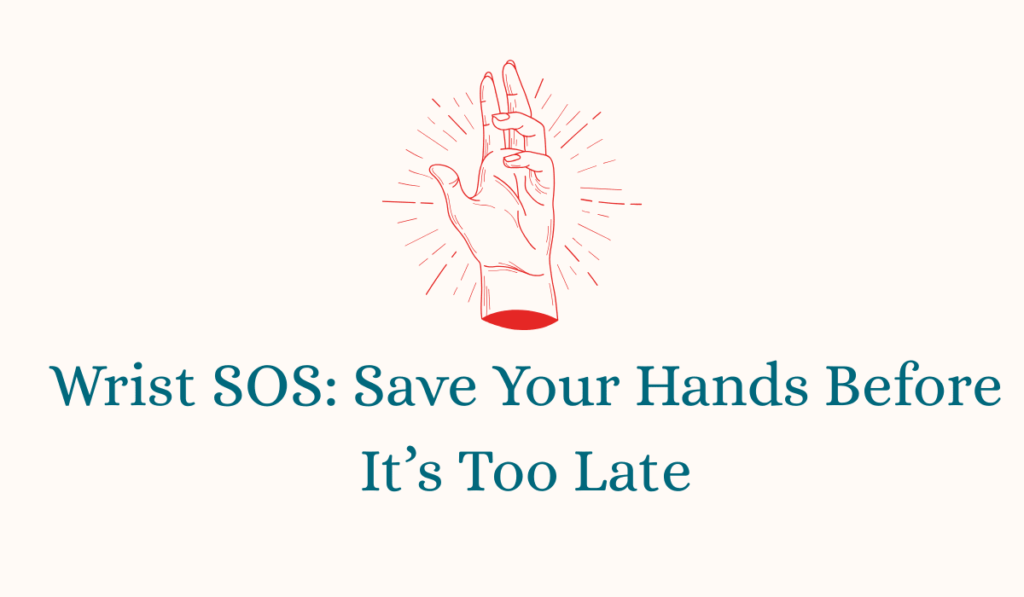Cold Therapy for the Busy Working Indian: Science, Practical Hacks & Women’s Cycle Tips
Cold therapy (cold showers, ice baths, bucket soaks) is no longer a “biohacker fad.” Research shows it helps with muscle soreness, recovery, mood, and alertness. For busy Indian professionals juggling work, commute, and family, here’s a science-backed, practical guide.
What Science Actually Says
- Reduces soreness & fatigue: Cold water immersion (11–15°C for 10–15 mins) helps muscle recovery after hard exercise.
- Timing matters: If your goal is muscle growth, avoid full-body cold immersion right after lifting it can blunt adaptation. Use it later or on rest days.
- Mood boost: Cold stimulates the nervous system → short-term alertness, longer-term calm.
- Women’s responses differ: Hormones shift body temperature and cold tolerance throughout the cycle. Adjust exposure for comfort and recovery.
How Cold Works (in plain words)
- Constriction & flush: Cold shrinks blood vessels → reduces swelling. On rewarming, blood rushes back → clears waste.
- Pain gate: Cold slows nerve signals → lowers pain sensation.
- Inflammation balance: Too much cold may reduce signals needed for muscle building.
- Nervous system reset: Short stress → energy spike, then parasympathetic relaxation.
Easy India-Friendly Protocols
1)Cold-Finish Shower (Daily)
- End a normal shower with 30–180s of cold water.
- Best for morning alertness or a quick reset after the office.
2) Bucket/Leg Soak (Commute-Friendly)
- Soak feet/legs in cold tap water 5–10 mins (add ice if needed).
- Relieves leg heaviness and fatigue.
3) Ice Bath / Tub (Weekly Recovery)
- 8–12 mins at ~11–15°C after long runs or exhausting sessions.
- Do 1–3 times/week, not daily.
4) Ice Pack (Targeted Relief)
- Wrap ice pack; apply 10–15 mins to sore back, knees, or shoulders.
- Great for office breaks.
When to Use It
- For soreness: Within an hour after intense workouts.
- For growth goals: Skip immediate cold after lifting; use later or on rest days.
- For stress/mood: Morning cold shower or contrast shower (warm → cold cycles).
Women: Cycle-Smart Cold Therapy
- Menstrual phase: Use localized cold (abdomen/back) for cramps; gentler showers.
- Follicular/Ovulation: Best tolerance → try longer immersions.
- Luteal (pre-period): Body temp is higher, cold may feel harder, shorten exposures.
- General rule: Cold is a stressor; if tired, undereating, or low on sleep, scale back.
Weekly Cold Plan (Example)
- Mon (post-gym): 3-min cold finish shower.
- Tue (long commute): Leg bucket soak at night.
- Wed (run): 10-min tub soak.
- Thu: Quick cold shower for alertness.
- Fri (strength day): No post-gym plunge; only localized cold if sore.
- Sat (long training): 10–12 min ice bath.
- Sun: Optional gentle cold shower.
Safety First
- Heart problems, hypertension, thyroid, or pregnancy → consult a doctor.
- Don’t overdo it: stop if numb, dizzy, or shivering heavily.
- Warm up naturally after (walk, towel, light movement).
Takeaway
Cold therapy is simple, cheap, and effective for recovery, stress, and energy — if done smartly. Start with 30–60s cold showers, scale up to buckets or baths when time allows, and for women, adjust intensity by cycle phase.
Key Sources
- Effects of Cold Water Immersion after Exercise on Fatigue Recovery — shows CWI reduces muscle soreness, perceived exertion, and some damage markers after intense exercise. PMC
- Post-exercise Cold Water Immersion Effects on Physiological Adaptations — demonstrates how cold immediately after resistance training can reduce muscle protein synthesis and blunt hypertrophy responses. Frontiers+2PMC+2
- Post-exercise cold water immersion attenuates long-term gains in muscle mass and strength — explores how repeated use of cold immersion may reduce muscle and strength gains over time compared to non-cold recovery. PMC
- Can Water Temperature and Immersion Time Influence the Effect of CWI? — This reviews what temperatures (≈ 11-15 °C) and durations (≈ 11-15 mins) tend to be most effective. SpringerLink
- “Throwing cold water on muscle growth: A systematic review …” — examines evidence that using cold immersion immediately after resistance-training may reduce hypertrophy. Wiley Online Library+1
- No acceleration of recovery from exercise-induced muscle damage after cold or hot water immersion in women — a study focused on women, showing that in some protocols, neither cold nor hot immersion produced big recovery gains over control. Useful for understanding sex-/gender differences. PLOS
- Impact of different doses of cold water immersion (duration and temperature) on recovery — more recent work clarifying how varying temperature/duration change outcomes. Frontiers
Summary
Cold therapy is more than a fad — it’s a proven method to ease muscle soreness, speed up recovery, and improve mood. For busy Indian professionals, it’s also practical and affordable. Cold showers, bucket soaks, ice baths, or simple ice packs can be used daily or weekly, depending on goals.
The key is timing: use cold soon after intense exercise to reduce soreness, but avoid it immediately after strength training if your goal is muscle growth. For stress and alertness, cold showers or contrast showers in the morning are ideal. Women should adjust cold exposure based on their cycle, with longer immersions tolerated better during the follicular phase and shorter, gentler sessions during the luteal or menstrual phases.
When practiced smartly and safely, cold therapy becomes a simple tool for better performance, energy, and resilience in everyday life.
❓ FAQs
Is cold therapy safe for everyone?
Cold exposure stresses the body, so it isn’t suitable for everyone. People with heart disease, hypertension, thyroid issues, or women who are pregnant should consult their doctor before trying it. Even for healthy individuals, it’s important to start gradually — begin with 30–60 seconds of cold showers and build tolerance.
How long should I stay in an ice bath?
The sweet spot is usually 8–12 minutes at 11–15°C. Going beyond this doesn’t add much benefit and may increase risks like numbness, dizziness, or hypothermia. If you’re new, start with shorter dips (2–3 minutes) and work up gradually.
Will cold therapy stop muscle growth?
Cold therapy can blunt muscle-building signals if used immediately after strength training. This happens because cold reduces inflammation and protein synthesis, both of which are needed for hypertrophy. If muscle growth is your main goal, skip post-lift immersions and instead use cold therapy later in the day or on recovery days.
What’s the easiest way to start cold therapy?
The most accessible option is a cold-finish shower: at the end of your regular shower, switch to cold water for 30–60 seconds. You can extend up to 2–3 minutes as you get used to it. For commuters, a quick leg soak in a bucket of cold water at night is another easy way to reduce fatigue.
Are there specific tips for women?
Yes — women’s cold tolerance can vary across the menstrual cycle. During the menstrual phase, gentler cold (like localized packs for cramps) is best. During the follicular and ovulation phases, tolerance is highest, making it the best time for longer immersions or ice baths. In the luteal phase, when body temperature is slightly higher, shorter exposures feel more comfortable. The golden rule is to adjust intensity based on how your body feels.
📞 Ready to Level Up Your Recovery?
Cold therapy is just one piece of a high-performance lifestyle. If you want personalized recovery strategies for busy professionals, let’s talk.
👉 Book a Book Consultation and get a tailored plan for your work-life-energy balance.



